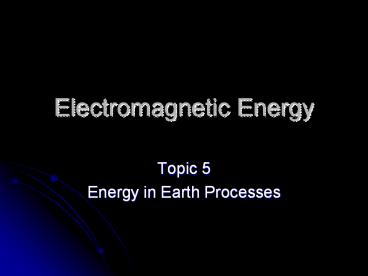Electromagnetic Energy - PowerPoint PPT Presentation
1 / 16
Title:
Electromagnetic Energy
Description:
Electromagnetic Energy Topic 5 Energy in Earth Processes energy The ability to do work Electromagnetic energy The type of energy given off in transverse waves by all ... – PowerPoint PPT presentation
Number of Views:95
Avg rating:3.0/5.0
Title: Electromagnetic Energy
1
Electromagnetic Energy
- Topic 5
- Energy in Earth Processes
2
energy
- The ability to do work
3
Electromagnetic energy
- The type of energy given off in transverse waves
by all matter above absolute zero - Each kind of e-mag energy has its own wavelength
4
wavelength
5
Electromagnetic spectrum
- A model showing all the forms of e-mag energy
6
- Page 14 ESRT
- Visible light can be broken down into colors by
wavelength.
7
The hotter the object the more e-mag energy it
gives off.
high
Amount of e-mag energy given off
low
hot
cold
Temperature of Object
8
The hotter the object, the shorter the wavelength
given off.
long
Wavelength
short
hot
cold
Temperature of Object
9
E-mag waves can be
10
(No Transcript)
11
The characteristics of a surface determine the
amount and kind of e-mag energy absorbed.
- Color - dark absorb more/reflect less
- Texture (rough/smooth) - rough absorbs more
- Luster/reflectivity (shiny/dull) - dull absorbs
more
12
source
- Region with a higher concentration of energy than
its surroundings
13
Sink (no, not the kitchen kind)
- Region with a lower energy concentration than its
surroundings - Energy always flows from a source to sink.
14
Energy is transferred across interfaces.
source
sink
50C
30C
The sink absorbs more than it radiates. temperatu
re increases
The source radiates more than it
absorbs. temperature decreases
15
Energy is transferred across interfaces.
The 2 objects absorb the same amount that they
radiate. temperature is constant This is called
dynamic equilibrium or radiative balance.
16
Energy Transformations
- When e-mag energy of short wavelength is
absorbed, it can be reradiated at longer
wavelengths. - A material that is a good absorber of
electromagnetic energy is a good radiator of
electromagnetic energy.































